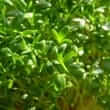Background
- Watercress originates from the eastern Mediterranean and adjoining areas of Asia. It is cultivated commercially for its small, pungent leaves that may be used as a salad green or garnish. Greek, Persian and Roman civilizations ate watercress for its health-related properties. The Greeks believed watercress was beneficial to the brain. Applied externally, it has a reputation as an effective hair tonic, helping to promote the growth of thick hair.
- Watercress is a member of the Brassicaceae family, which includes cabbage, broccoli, cauliflower, Brussels sprouts, kale, mustard greens, collard greens, bok choy and turnips. These plants contain specific indoles (aromatic organic compounds) that activate enzymes in the body; these enzymes then deactivate and dispose of excess estrogen. Heavy cooking destroys indoles and is not recommended for medicinal purposes.
- Watercress also contains phenethyl isothiocyanate (PEITC), which is a dietary compound present in cruciferous vegetables that has cancer-preventive properties.
- Watercress was formerly used as a domestic remedy against scurvy. The species Cochlearia officianalis is commonly referred to as scurvy grass; sailors would consume this plant to prevent scurvy from developing. Although this plant is referred to as watercress, scurvy grass has flowers with a strong fragrance and taste.
References
- Carrada-Bravo T. [Fascioliasis: diagnosis, epidemiology and treatment]. Rev Gastroenterol Mex 2003;68(2):135-142.
View Abstract - Chiao JW, Wu H, Ramaswamy G, et al. Ingestion of an isothiocyanate metabolite from cruciferous vegetables inhibits growth of human prostate cancer cell xenografts by apoptosis and cell cycle arrest. Carcinogenesis 2004;25(8):1403-1408.
View Abstract - Christmann M, Henrich R, Mayer G, et al. [Infection with fasciola hepatica causing elevated liver-enzyme results and eosinophilia - serologic and endoscopic diagnosis and therapy]. Z Gastroenterol 2002;40(9):801-806.
View Abstract - Conaway CC, Yang YM, Chung FL. Isothiocyanates as cancer chemopreventive agents: their biological activities and metabolism in rodents and humans. Curr Drug Metab 2002;3(3):233-255.
View Abstract - Cosme A, Ojeda E, Poch M, et al. Sonographic findings of hepatic lesions in human fascioliasis. J Clin Ultrasound 2003;31(7):358-363.
View Abstract - Dobrucali A, Yigitbasi R, Erzin Y, et al. Fasciola hepatica infestation as a very rare cause of extrahepatic cholestasis. World J Gastroenterol 2004;10(20):3076-3077.
View Abstract - Dreyfuss G, Vignoles P, Abrous M, et al. Unusual snail species involved in the transmission of Fasciola hepatica in watercress beds in central France. Parasite 2002;9(2):113-120.
View Abstract - Dreyfuss G, Vignoles P, Rondelaud D. Fasciola hepatica: epidemiological surveillance of natural watercress beds in central France. Parasitol Res 2005;95(4):278-282.
View Abstract - Hu R, Kim BR, Chen C, et al. The roles of JNK and apoptotic signaling pathways in PEITC-mediated responses in human HT-29 colon adenocarcinoma cells. Carcinogenesis 2003;24(8):1361-1367.
View Abstract - Ji Y, Morris ME. Determination of phenethyl isothiocyanate in human plasma and urine by ammonia derivatization and liquid chromatography-tandem mass spectrometry. Anal Biochem 2003;323(1):39-47.
View Abstract - Martinez-Bebert K, Rodriguez-Baez R, Pila-Perez R, et al. [Hepatic hematoma caused by fascioliasis]. Gac Med Mex 2002;138(3):271-274.
View Abstract - Robinson B, Duwig C, Bolan N, et al. Uptake of arsenic by New Zealand watercress (Lepidium sativum). Sci Total Environ 2003;301(1-3):67-73.
View Abstract - Rondelaud D, Hourdin P, Vignoles P, et al. The contamination of wild watercress with Fasciola hepatica in central France depends on the ability of several lymnaeid snails to migrate upstream towards the beds. Parasitol Res 2005;95(5):305-309.
View Abstract - Rose P, Huang Q, Ong CN, et al. Broccoli and watercress suppress matrix metalloproteinase-9 activity and invasiveness of human MDA-MB-231 breast cancer cells. Toxicol Appl Pharmacol 2005;
View Abstract - Yilmaz H, Godekmerdan A. Human fasciolosis in Van province, Turkey. Acta Trop 2004;92(2):161-162.
View Abstract







